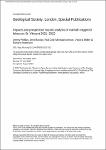Impacts and prospective hazard analysis of rainfall-triggered lahars on St. Vincent 2021–2022
| dc.contributor.author | Phillips, J | |
| dc.contributor.author | Barclay, J | |
| dc.contributor.author | Cole, Paul | |
| dc.contributor.author | Johnson, M | |
| dc.contributor.author | Miller, V | |
| dc.contributor.author | Robertson, R | |
| dc.date.accessioned | 2023-08-16T07:57:46Z | |
| dc.date.available | 2023-08-16T07:57:46Z | |
| dc.date.issued | 2024-04 | |
| dc.identifier.issn | 0305-8719 | |
| dc.identifier.issn | 2041-4927 | |
| dc.identifier.uri | https://pearl.plymouth.ac.uk/handle/10026.1/21233 | |
| dc.description.abstract |
Lahars are energetic flows of loosely consolidated volcanic debris and water, which have occurred frequently after rainfall events on St Vincent in the Eastern Caribbean since the April 2021 explosive phase of the 2020-21 eruption of La Soufriere volcano. Using scientific observations and information from social media, we have constructed a detailed timeline of 25 lahar events that occurred during 2021, and summarised lahar impacts and losses. 20 mm daily rainfall on a river catchment is (and remains) sufficient to result in a lahar. We used this threshold, with field estimates of lahar volumes, to conduct both an island-wide assessment of potentially impacted locations using the LAHARZ model, and a detailed reconstruction of one lahar event, using the dynamic model LaharFlow. A simplified catchment hydrology approach with runoff ratios typical for the Caribbean showed good agreement with observations of flow properties near the coast. Lahars will continue to be an important hazard in St Vincent into the future, and our modelling approach can assess future lahar impacts and provide early warnings. Social media provided key information about lahars and impacts, and allowed communities to alert each other. Future hazard mitigation should strengthen links between communities and with national risk management. | |
| dc.format.extent | sp539-2022-313- | |
| dc.language | en | |
| dc.publisher | Geological Society of London | |
| dc.title | Impacts and prospective hazard analysis of rainfall-triggered lahars on St. Vincent 2021–2022 | |
| dc.type | journal-article | |
| plymouth.issue | 1 | |
| plymouth.volume | 539 | |
| plymouth.publication-status | Published online | |
| plymouth.journal | Geological Society, London, Special Publications | |
| dc.identifier.doi | 10.1144/sp539-2022-313 | |
| plymouth.organisational-group | |Plymouth | |
| plymouth.organisational-group | |Plymouth|Faculty of Science and Engineering | |
| plymouth.organisational-group | |Plymouth|Faculty of Science and Engineering|School of Geography, Earth and Environmental Sciences | |
| plymouth.organisational-group | |Plymouth|REF 2021 Researchers by UoA | |
| plymouth.organisational-group | |Plymouth|Users by role | |
| plymouth.organisational-group | |Plymouth|Users by role|Academics | |
| plymouth.organisational-group | |Plymouth|REF 2021 Researchers by UoA|UoA07 Earth Systems and Environmental Sciences | |
| dcterms.dateAccepted | 2023-08-01 | |
| dc.date.updated | 2023-08-16T07:57:40Z | |
| dc.rights.embargodate | 2023-8-17 | |
| dc.identifier.eissn | 2041-4927 | |
| dc.rights.embargoperiod | forever | |
| rioxxterms.versionofrecord | 10.1144/sp539-2022-313 |


